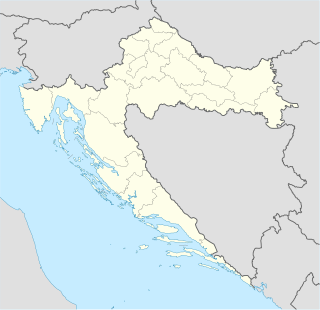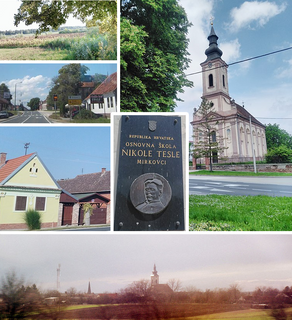
Borovo, locally known as Borovo selo, is a village and an eponymous municipality in Vukovar-Srijem County in eastern Croatia. It is situated on the river Danube on the border with Serbia. While being a municipality in its own right, Borovo is closely related with neighboring Vukovar, to which it is physically connected. It is a biggest settlement in Croatia in which Serbs of Croatia constitute ethnic majority.

Pećinci is a town and municipality located in the Srem District of the autonomous province of Vojvodina, Serbia. The village has a population of 2,571 (2011), while Pećinci municipality has 19,675 inhabitants.

The Battle of Borovo Selo of 2 May 1991, known in Croatia as the Borovo Selo massacre and in Serbia as the Borovo Selo incident, was one of the first armed clashes in the conflict which became known as the Croatian War of Independence. The clash was precipitated by months of rising ethnic tensions, violence, and armed combat in Pakrac and at the Plitvice Lakes in March. The immediate cause for the confrontation in the heavily ethnic Serb village of Borovo Selo, just north of Vukovar, was a failed attempt to replace the Yugoslav flag in the village with the flag of Croatia. The unauthorised effort by four Croatian policemen resulted in the capture of two by a Croatian Serb militia in the village. To retrieve the captives, the Croatian authorities deployed additional police, who drove into an ambush. Twelve Croatian policemen and one Serb paramilitary were killed before the Yugoslav People's Army (JNA) intervened and put an end to the clashes.

Negoslavci is a village and a municipality in Vukovar-Srijem County, Croatia.

The Lovas killings involved the killing of 70 Croat civilian residents of the village of Lovas between 10–18 October 1991, during the Croatian War of Independence. The killings took place during and in the immediate aftermath of the occupation of the village by the Yugoslav People's Army supported by Croatian Serb forces and Dušan Silni paramilitaries on 10 October, two days after Croatia declared independence from Yugoslavia. The occupation occurred during the Battle of Vukovar, as the JNA sought to consolidate its control over the area surrounding the city of Vukovar. The killings and abuse of the civilian population continued until 18 October, when troops guarding a group of civilians forced them to walk into a minefield at gunpoint and then opened fire upon them.

The Baćin massacre was the killing of 83 civilians just outside the village of Baćin, near Hrvatska Dubica, committed by Croatian Serb paramilitaries. The killings took place on 21 October 1991 during the Croatian War of Independence. Most of the civilians were Croats, but they also included two ethnic Serbs, taken from Hrvatska Dubica, Baćin and the nearby village of Cerovljani. The civilians were killed in the area of Krečane, at the very bank of the Una River, and their bodies were left unburied for two weeks. Most of them were subsequently bulldozed into a shallow mass grave, while a number of the bodies were thrown into the river.

Hrtkovci is a village located in the municipality of Ruma, Serbia. As of 2011 census, it has a population of 3,036 inhabitants.

Seline is a village in the Starigrad municipality of Zadar County, Croatia. Seline has a population of 455 ,. The population is by and large Croatian.

The Voćin massacre was the killing of 43 civilians in Voćin, Croatia, by the Serbian White Eagles paramilitary unit on 13 December 1991, during the Croatian War of Independence. The massacre was carried out after the unit was ordered to abandon the village before the Croatian Army recaptured the area in Operation Papuk-91. All the victims were local Croats, save one Serb, who had tried to protect his neighbours. Gunfire was the leading cause of death, though some of the victims were killed with axes or chainsaws, or were burned to death. The victims exhibited signs of torture and were left unburied. On the night of 13–14 December, the White Eagles dynamited a 550-year-old church in the village.

The Jabukovac killings occurred July 27, 2007, when the villager Nikola Radosavljević took a hunting rifle and shot dead five men and four women in the Serbian village of Jabukovac, near the border with Romania and Bulgaria. Three other people in addition to the perpetrator were injured.

Jabukovac is a village in Serbia. It is located in the municipality of Negotin, in the Bor District, near the borders between Serbia, Romania and Bulgaria.

Kukujevci is a village in Serbia. It is situated in the Šid municipality, in the Srem District, Vojvodina province. The village has a Serb ethnic majority and its population numbering 2,252 people.

Mirkovci is a village and suburb of the town of Vinkovci in eastern Croatia. It is geographically within the Syrmia region. The village is located immediately southeast of Vinkovci separated from the rest of the town by Vinkovci-Gunja railway. At the time of 2011 Census, the local population was 3,283.

Deligrad (Jabukovac ) is a village in the municipality of Aleksinac, Serbia. According to the 2002 census, the village has a population of 211 people.

The Erdut killings were a series of murders of 37 Hungarian and Croat civilians in the village of Erdut, Croatia committed by Croatian Serb forces and Serb Volunteer Guard paramilitaries between November 1991 and June 1992, during the Croatian War of Independence. Twenty-two Hungarians and 15 Croats were killed. The first killings occurred on 10 November 1991, when twelve civilians died. Eight more were killed over the following several days. Five more civilians were killed on 10 December, and another seven on 16 December. Four others were killed on 21 February 1992 and the final one was killed on 3 June. The bodies of these victims were either buried in mass graves or thrown into nearby wells.

Following the beginning of the Yugoslav wars, especially the War in Croatia in 1991, members of Serbian Radical Party and Serbian Chetnik Movement have conducted a campaign of intimidation and persecution of Croats of Serbia in Vojvodina, Serbia, through hate speech. These acts forced a part of the local Croat population to leave the area in 1992. Most of them were resettled in Croatia. The affected locations included Hrtkovci, Nikinci, Novi Slankamen, Ruma, Šid, and other places bordering Croatia. According to some estimates, around 10,000 Croats left Vojvodina in 1992.
The Varivode massacre was a mass killing that occurred on 28 September 1995 in the village of Varivode, Croatia during the Croatian War of Independence. According to United Nations officials, soldiers of the Croatian Army (HV) and Croatian police killed nine Croatian Serb villagers, all of whom were between the ages of 60 and 85. After the war, six former Croatian soldiers were tried for committing crimes in the village, but were all eventually released due to lack of evidence. In 2012, the Supreme Court of Croatia ruled that the Republic of Croatia was responsible for the killings, dubbing the massacre an "act of terrorism," and the following year the municipal court in Knin announced that the Government of Croatia must provide compensation to the children of a couple who were murdered.

The Paulin Dvor massacre was an act of mass murder committed by soldiers of the Croatian Army (HV) in the village of Paulin Dvor, near the town of Osijek on 11 December 1991 during the Croatian War of Independence. Of the nineteen victims, eighteen were ethnic Serbs, and one was a Hungarian national. The ages of the victims, eight women and eleven men, ranged from 41 to 85. Two former Croatian soldiers were convicted for their role in the killings and were sentenced to 15 and 11 years, respectively. In November 2010, Croatian President Ivo Josipović laid a wreath at the graveyard of the massacre victims and officially apologized for the killings.

Operation Stinger was an offensive undertaken by the forces of the SAO Krajina, an unrecognized Croatian Serb region opposing the Republic of Croatia, against positions held by the Croatian police in the region of Banovina on 26–27 July 1991, during the Croatian War of Independence. It was primarily aimed at police stations in Glina and Kozibrod, as well as police-held positions in a string of villages between the town of Dvor and Kozibrod. In addition to Glina and Kozibrod, heavy fighting took place in the village of Struga, north of Dvor, where Croatian Serb forces employed a human shield consisting of Croat civilians taken from their homes in Struga and the nearby village of Zamlača.

Jabukovac is a village in central Croatia, in the Town of Petrinja, Sisak-Moslavina County. It is connected by the D30 highway.











